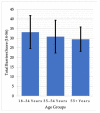Exercise Promotion in Saudi Arabia: Understanding Personal, Environmental, and Social Determinants of Physical Activity Participation and Well-Being
- PMID: 36834247
- PMCID: PMC9965198
- DOI: 10.3390/ijerph20043554
Exercise Promotion in Saudi Arabia: Understanding Personal, Environmental, and Social Determinants of Physical Activity Participation and Well-Being
Abstract
Physical activity promotion has received increasing attention globally due to the considerable benefits of regular activity for population health and well-being. In Saudi Arabia, government strategy explicitly aims to increase physical activity participation among residents. This study assessed the barriers to physical activity among the general Saudi population including any age and gender differences and examined the contribution of contextual factors and nature relatedness to health and well-being. A representative sample of 1046 Saudi adults (aged 18 years and above) completed an online survey that included four validated scales: the International Physical Activity Questionnaire-short form, the Exercise Benefits/Barriers Scale, the World Health Organization Five Well-Being Index and the Nature Relatedness Scale. Analyses indicated that young Saudi adults perceived more barriers than middle-aged and older adults, but few gender differences were observed. Furthermore, exercising outdoors, with other people and via sport predicted higher levels of mental well-being, as did nature relatedness. Therefore, developing a comprehensive strategy package that includes the development of outdoor environments for all age groups across regions and fostering a connection with nature may be particularly effective to improve the health and well-being of Saudi adults.
Keywords: Saudi Arabia; barriers; exercise; health; nature relatedness; physical activity; well-being.
Conflict of interest statement
The authors declare no conflict of interest.
Figures
Similar articles
-
Perceived barriers to physical activity and their predictors among adults in the Central Region in Saudi Arabia: Gender differences and cultural aspects.PLoS One. 2025 Feb 7;20(2):e0318798. doi: 10.1371/journal.pone.0318798. eCollection 2025. PLoS One. 2025. PMID: 39919050 Free PMC article.
-
Exploring Female University Students' Participation in Physical Activity in Saudi Arabia: A Mixed-Methods Study.Front Public Health. 2022 Mar 18;10:829296. doi: 10.3389/fpubh.2022.829296. eCollection 2022. Front Public Health. 2022. PMID: 35372244 Free PMC article.
-
Barriers and facilitators affecting physical activity among adults in Saudi Arabia during COVID-19 quarantine.Health Promot Int. 2023 Jun 1;38(3):daab191. doi: 10.1093/heapro/daab191. Health Promot Int. 2023. PMID: 34849922
-
Physical activity promotion in Saudi Arabia: A critical role for clinicians and the health care system.J Epidemiol Glob Health. 2018 Mar;7 Suppl 1(Suppl 1):S7-S15. doi: 10.1016/j.jegh.2017.10.005. Epub 2017 Oct 24. J Epidemiol Glob Health. 2018. PMID: 29801594 Free PMC article. Review.
-
Impact of COVID-19 Pandemic on Training and Well-Being in Radiology Residency: A National Survey of Diagnostic Radiology Trainees in Saudi Arabia.Acad Radiol. 2021 Jul;28(7):1002-1009. doi: 10.1016/j.acra.2021.03.019. Epub 2021 Apr 21. Acad Radiol. 2021. PMID: 33893029 Review.
Cited by
-
Application of the health belief model to study weight management behavioral intentions among adults in Ho Chi Minh City, Vietnam: a cross-sectional study.BMC Public Health. 2025 Jul 11;25(1):2436. doi: 10.1186/s12889-025-23637-9. BMC Public Health. 2025. PMID: 40646482 Free PMC article.
-
Impact of forestry on environment and human health: an evidence-based investigation.Front Public Health. 2023 Sep 1;11:1260519. doi: 10.3389/fpubh.2023.1260519. eCollection 2023. Front Public Health. 2023. PMID: 37744506 Free PMC article.
-
Interactions with Nature, Good for the Mind and Body: A Narrative Review.Int J Environ Res Public Health. 2024 Mar 12;21(3):329. doi: 10.3390/ijerph21030329. Int J Environ Res Public Health. 2024. PMID: 38541328 Free PMC article. Review.
-
Predictors of physical activity and public safety perception regarding technology adoption for promoting physical activity in Jeddah, Saudi Arabia.Prev Med Rep. 2024 May 10;43:102753. doi: 10.1016/j.pmedr.2024.102753. eCollection 2024 Jul. Prev Med Rep. 2024. PMID: 38798910 Free PMC article.
References
-
- Arem H., Moore S.C., Patel A., Hartge P., Berrington de Gonzalez A., Visvanathan K., Campbell P.T., Freedman M., Weiderpass E., Adami H.O., et al. Leisure time physical activity and mortality: A detailed pooled analysis of the dose-response relationship. JAMA Intern. Med. 2015;175:959–967. doi: 10.1001/jamainternmed.2015.0533. - DOI - PMC - PubMed
-
- Giandonato J.A., Tringali V.M., Thoms R.C. Improving mental health through physical activity: A narrative literature review. Phys. Act. Health. 2021;5:146–153. doi: 10.5334/paah.108. - DOI
-
- Guthold R., Stevens G.A., Riley L.M., Bull F.C., Bull F.C. Worldwide trends in insufficient physical activity from 2001 to 2016: A pooled analysis of 358 population-based surveys with 1·9 million participants. Lancet Glob. Health. 2018;6:e1077–e1086. doi: 10.1016/S2214-109X(18)30357-7. - DOI - PubMed
-
- WHO Global Action Plan on Physical Activity 2018–2030: More Active People for a Healthier World. World Health Organization; Geneva, Switzerland: 2018.
MeSH terms
LinkOut - more resources
Full Text Sources
Medical


